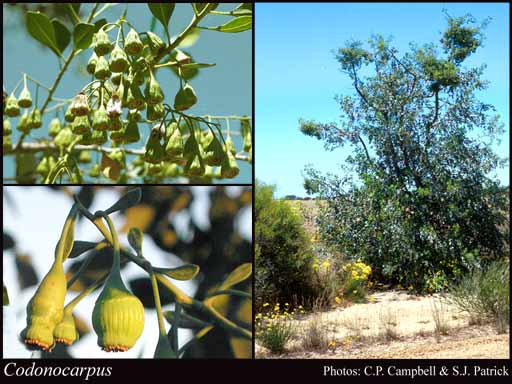- Reference
- Enum.Pl. 10 (1837)
- Name Status
- Current







Scientific Description
Common name. Bell fruit. Family Gyrostemonaceae.
Habit and leaf form. Trees (small), or shrubs. Leaves cauline. Young stems cylindrical. Stem internodes solid. Xerophytic. Leaves small, or medium-sized; alternate; spiral; fleshy, or ‘herbaceous’ to leathery; petiolate, or sessile (rarely); non-sheathing; simple; epulvinate. Leaf blades entire; flat; linear, or lanceolate, or oblanceolate, or oblanceolate, or ovate; broadly ovate (to narrowly lanceolate), or obovate, or linear; one-veined, or pinnately veined. Leaves with stipules (small). Leaf blade margins entire. Leaves without a persistent basal meristem. Leaf anatomy. Hairs absent (usually glaucous). Extra-floral nectaries absent. Stem anatomy. Secondary thickening developing from a conventional cambial ring.
Reproductive type, pollination. Fertile flowers functionally male and functionally female, or functionally male, or functionally female. Unisexual flowers present. Plants monoecious, or dioecious. The unisexual flowers segregated in different inflorescences. Female flowers without staminodes. Male flowers without pistillodes.
Inflorescence and flower features. Flowers aggregated in ‘inflorescences’; in racemes, or in spikes, or in panicles. The terminal inflorescence unit racemose. Inflorescences terminal (panicles), or axillary (racemes); female flowers in racemes and often also in panicles, also on the leafless bases of the year's shoot; male flowers in racemes; may be up to 15 flowers per raceme. Flowers pedicellate (male flowers - short, female flowers - long); bracteate (minute); bracteolate (very small); small; regular (or almost regular); cyclic. Perianth sepaline; 4–5 (if segments detectable); 1 -whorled; joined. Calyx present; 4, or 5 (when lobed); 1 -whorled; gamosepalous; toothed; regular; persistent. Corolla absent. Fertile stamens present, or absent. Androecial members definite in number. Androecium 10–20. Androecial sequence determinable, or not determinable. Androecial members when in more than one cycle, maturing centripetally; free of the perianth; all equal; free of one another; 1–5 -whorled. Androecium exclusively of fertile stamens. Stamens 10–20; all more or less similar in shape; polystemonous; around edge of expanded receptacle that has a central nectary disc; with sessile anthers (almost). Anthers dehiscing via longitudinal slits; introrse. Fertile gynoecium present, or absent. Gynoecium 20–60 carpelled. The pistil 20–60 celled. Gynoecium apocarpous, or syncarpous; semicarpous to synovarious (the carpels adnate to the central column, forming a compound ovary); superior. Carpel stylate; apically stigmatic; 1 ovuled. Placentation marginal. Ovary plurilocular; 20–60 locular. Gynoecium stylate. Styles 1 per carpel; apical. Stigmas 1 per carpel. Placentation axile. Ovules 1 per locule; apotropous; arillate; anatropous.
Fruit and seed features. Fruit non-fleshy; not an aggregate (individual carpels have scarious sides); a schizocarp. Mericarps comprising follicles (mericarps dehisce on the adaxial margin but this often happens after shedding). Seeds copiously endospermic. Endosperm oily. Embryo well differentiated. Cotyledons 2. Embryo curved.
Physiology, biochemistry. Mustard-oils present.
Etymology. From the Greek for "bell" and "fruit".
Taxonomic Literature
- Blackall, William E.; Grieve, Brian J. 1988. How to know Western Australian wildflowers : a key to the flora of the extratropical regions of Western Australia. Part I : Dicotyledons (Casuarinaceae to Chenopodiaceae). University of W.A. Press.. [Perth]..